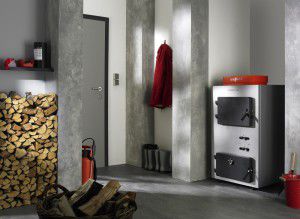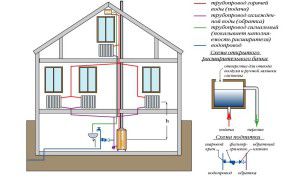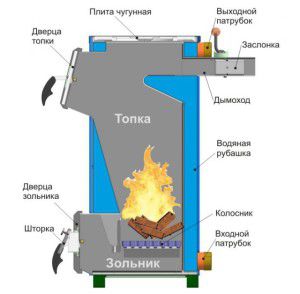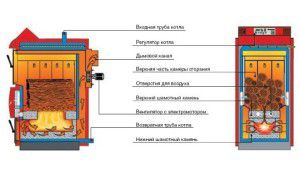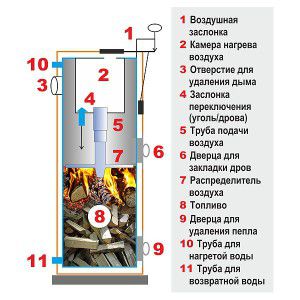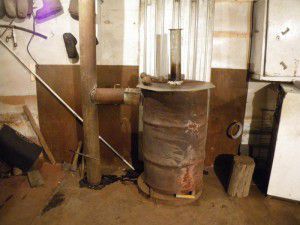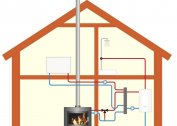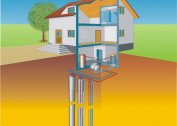The process of designing and installing solid fuel heating differs from similar special requirements. Not only the characteristics of the boiler or furnace are taken into account, but also the safety rules and the efficiency of the entire system. Knowing these nuances will help to make the heating of a private house on solid fuel: boilers, stoves and a chimney system.
Main parameters of boilers and solid fuel furnaces
Solid fuel heat supply is characterized by relatively low initial costs. Affordable affordable solid fuel heating boilers are available on the market. However, the installation process of the equipment and the entire system as a whole must be carried out according to certain rules.
Almost all solid fuel stoves and boilers for water heating have the same characteristics. Their knowledge and ability to correctly use the information will help to choose the right equipment for heating the house. When choosing, you should pay attention not only to technical aspects, but also to workmanship. Solid fuel boilers for home heating should be made of special grades of steel. Case thickness is at least 2 mm. For the combustion chamber, heat-resistant steel with a thickness of 3 mm or more is used.
The advantage will be a guarantee from the manufacturer and seller of heating equipment. You also need to pay attention to the presence of a network of service centers for maintenance and repair. In order for the reviews of solid fuel heating boilers to be only positive in choosing equipment, one should study the following parameters:
- Rated power. It is determined by preliminary calculations of heat supply. To form a small supply, heating a private house with solid fuel should have a capacity of 15-20% more than the calculated one;
- Heat exchanger fabrication material. The most reliable are cast-iron solid fuel boilers. Their disadvantage is a large indicator of inertness and possible destruction with strong mechanical stress. An alternative is lighter and cheaper models with a steel heat exchanger;
- Type of boiler. In addition to the classic direct combustion equipment, you can choose pyrolysis or long burning boilers.
Often do solid fuel heating boilers do it yourself. But to perform this work, you need to choose the right manufacturing scheme and materials. The advantage of such designs is the ability to adapt according to the above parameters to a specific heating system.
All stoves for air heating using solid fuel are designed for the use of coal, firewood, fuel briquettes or peat. Exceptions are pellet boilers, which differ in design and are intended only for pellets.
Solid fuel heating schemes
Installation of heating equipment is preceded by a choice of circuit. The complete set of heat supply, the parameters of the system, as well as the type of coolant depend on it. In some cases, a solid fuel steam heating scheme is appropriate. But most often they choose water heat supply at home.
The choice is determined by the characteristics of the house - its area, heat loss and the required temperature of the heating operation.For uniform heat distribution, a recommended installation scheme for a solid fuel heating boiler in a water circuit. If the area of the house is small - you can apply air heat supply. In rare cases, home-made solid-fuel heating boilers are used.
At the first stage of choosing the installation scheme for a solid fuel heating boiler, it is difficult to determine the type of heat supply. Currently, the most common types are:
- Watermark with natural circulation. Applicable for small private houses and cottages. This is due to the maximum possible length of the line up to 30 m. Even with a powerful heating boiler for a solid fuel house, the water circulation indicator will be small;
- Water with forced circulation. For this type of heat supply, it is possible to consider the manufacture of a solid fuel heating boiler with an integrated pump. Thanks to this design, the heating area is significantly increased;
- Aerial. It can be realized with the help of special boilers for heating on solid fuel with your own hands, in which the design provides channels for the circulation of warm air. An alternative is to install an air heat exchanger and a duct system to distribute heated air throughout the rooms of the house;
- Steam. In autonomous heating it is used extremely rarely due to the high cost of equipment and the need for constant monitoring of the state of the coolant. Most solid fuel steam heating schemes are designed to heat large buildings.
The best option for installing a home heating boiler for solid fuels is water heating with forced circulation. It has good performance, low maintenance. You can also note a large number of schemes according to which you can independently calculate the heating boiler for solid fuel.
In any heating system, regardless of the selected scheme, safety elements must be present. For solid fuel boilers for water heating, these are air vents, drain and check valves.
Direct burning boilers
The simplest device for a solid fuel heating boiler is the classic model. They consist of a combustion chamber, an ash pan, a heat exchanger and a chimney pipe. The transfer of thermal energy to water occurs due to the combustion of fuel in the furnace.
The advantage of such models is the reliability and simplicity of design. For the independent manufacture of a solid fuel heating boiler of this type, a minimum of tools and materials will be needed.
But along with the positive qualities, these boilers have several disadvantages. The main one is high fuel consumption. In reviews of direct burning solid fuel heating boilers, the need for the constant addition of firewood or coal is indicated. If this is not done, the temperature of the water in the pipes will inevitably decrease.
It should also be noted such features of heating a private house with solid fuel using boilers of this type:
- Great indicator of inertia. The time for heating the water in the pipes to the required temperature can be from 10 to 30 minutes, depending on the type of system and its characteristics;
- Power Adjustment Issues. As in solid fuel heating stoves, this can only be done by limiting the flow of air through the ash pan. Therefore, when designing a heating system, it is necessary to provide for the installation of safety devices;
- Low efficiency. Usually it is about 60-65%. This is due to the fact that some of the thermal energy leaves together with carbon monoxide through a chimney;
- Equipment. The composition of steel and cast iron heating boilers for solid fuels does not include a circulation pump, a safety group.
It is also worth noting the lack of a second circuit for hot water supply. Alternatively, you can consider the possibility of connecting a tank of direct or indirect heating, if so provided by the design. In this case, when calculating a solid fuel heating boiler, the installation of additional equipment should be considered.
In most cases, the device for a solid fuel heating boiler provides for a working time of 4 to 6 hours on one batch of firewood or coal. The higher the burning rate, the shorter the time for one cycle.
Solid fuel pyrolysis boilers
To optimize fuel consumption and increase efficiency, pyrolysis home heating boilers for solid fuel were developed. Despite the similarity of the processes occurring inside the structure, their operating principle differs from the described models of direct combustion.
Such solid fuel boilers for water heating are also called gas-generating boilers. Their principle of operation is not based on the direct combustion of firewood, but on the formation of a volatile mixture. With a relatively small temperature effect on the wood and with a minimum oxygen supply, the process of their decay occurs. As a result of this, the so-called wood gas is formed. Rising through special channels, it enters the combustion chamber, where it mixes up with the air stream and ignites.
The advantage of operating gas-fired boilers for heating for a solid fuel house is its economical fuel consumption. On average, one batch of firewood is enough for 12-18 hours of work. In addition, pyrolysis pig-iron solid fuel heating boilers are characterized by such qualities:
- Mains connection. For efficient operation, the boiler must be equipped with a fan or turbine (rare);
- Fuel quality. Before loading the firewood must pass the stage of drying. The optimum humidity for heating a private cottage with solid fuel should be 8-10%;
- The minimum amount of carbon monoxide. Most of them burn out in the secondary chamber. Due to this, when calculating a solid fuel boiler, a smaller chimney can be provided. But it must be insulated, since there is a high probability of condensation on its surface;
- Types of fuel. The device for a pyrolysis solid fuel heating boiler is made in such a way that logs, sawdust and wood waste can be used. It is important that they have the right moisture level and do not contain foreign impurities.
To regulate the power, do-it-yourself solid fuel heating boilers can connect a fan to the control unit. It will adjust the power of the device depending on the temperature indoors and outdoors. Thus, it is possible to reduce fuel consumption and optimize the operation of heating.
It is possible to improve the characteristics of a home-made solid-fuel heat-generating gas-generating boiler by lining its outer surface. This will reduce the heat loss of the structure.
Solid fuel boiler, long burning
One of the alternatives to the pyrolysis heating boiler is the long burning models. This is a relatively new heating design, which is characterized by low fuel consumption and a long period of its combustion.
The classic installation scheme of a solid fuel heating boiler provides for significant heating of water in a heat exchanger. Currently, low-temperature systems are gaining great popularity. It is for such schemes that a long-burning boiler will be optimal. It differs from classical models by the absence of an ash pan and the method of supplying air to maintain the combustion process.In reviews of boilers for long-burning solid fuel heating, their high efficiency and reliability are indicated.
Structurally, it consists of a large combustion chamber, occupying about 90% of the total volume of the boiler. Air is supplied through the upper pipe, which is lowered by the force of attraction as the fuel burns. In fact, a smoldering process occurs, due to which the temperature of the coolant does not exceed + 70 ° C.
It will be useful for the consumer to know the following properties of a long-burning boiler:
- Existence of the automatic draft regulator. This is a mechanical device with a thermocouple in its design. When it is heated, there is a decrease in air flow. The reverse process provokes a decrease in the temperature of the effect on the thermocouple;
- No power connection needed;
- Ash removal is carried out once every 3-4 days. However, with a large number of combustion products, a sharp deterioration in the operation of the boiler occurs;
- Burning occurs only at the top.. Due to this, a significant decrease in fuel consumption is observed.
One of the disadvantages of long-burning boilers is their high cost. However, with the correct design of the heating system, the compensation of primary costs will occur after 4-5 heating seasons. It is also necessary to protect the structure from moisture.
It is necessary to control the rate of circulation of the coolant. Its intense cooling can cause moisture to fall on the surface of the heat exchanger..
Self-made boiler
Often the manufacture of a solid fuel heating boiler is necessary for heating small areas - utility rooms, warehouses and garages. Therefore, less stringent requirements are imposed on such structures than on factory models.
For the manufacture of a solid fuel boiler, various steel tanks can be used. It is important that their wall thickness is at least 1.5 mm. The design equips a combustion chamber, an ash pan, and a chimney is mounted. Then, holes are cut out in it for installing the door for the furnace and the ash pan.
For the manufacture of a self-made solid fuel boiler, the following containers are most often used:
- Gas cylinders capacity 50 l. This is the best option for a design with a small capacity;
- Steel barrels. It is important that they are airtight and have the required wall thickness.
The main disadvantage of homemade models is their short life. For the manufacture of more complex boilers, large financial investments will be required. Therefore, it is more profitable to purchase a factory model of an economy class at an affordable price.
The video material contains detailed instructions for the manufacture of a pyrolysis solid fuel boiler:
